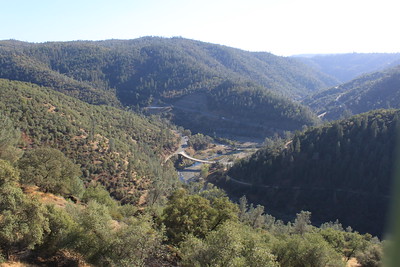
Private trout farm works with Service, others for conservation
“When you think of a private fish farm, you don’t typically think of conservation, but through a new partnership that is changing. U.S. Fish and Wildlife Service’s Coleman National Fish Hatchery and Mt. Lassen Trout Farm have come together to raise endangered Sacramento River winter-run Chinook salmon and release them into Battle Creek as part of the Jumpstart Project aimed at reintroducing winter-run to the watershed. Phil Mackey has been raising trout for nearly 50 years at the trout farm, so when biologists approached him about using one of their hatcheries as a location to raise endangered winter-run Chinook salmon he didn’t hesitate. ... ” Read more from the US FWS here: Private trout farm works with Service, others for conservation
If you look deep into the eyes of a fish, it will tell you its life story
“At least, that’s what CalTrout’s most recently published research, led by our partners at UC Davis, suggests. The study, just published in the journal Methods in Ecology and Evolution, demonstrated that stable isotopic analysis of salmon eye lenses can reveal a fish’s life history: where it swam and what it ate along the way. The work has major implications for tracking how salmon use floodplain habitat and for understanding how the Central Valley’s altered landscape is impacting fish populations. … ” Read more from Cal Trout here: If you look deep into the eyes of a fish, it will tell you its life story
OSU, USFS researchers use new method to track salmon, trout genetic diversity
“Scientists at Oregon State University and the U.S. Forest Service have demonstrated that DNA extracted from water samples from rivers across Oregon and Northern California can be used to estimate genetic diversity of Pacific salmon and trout. The findings, just published in the journal Molecular Ecology, have important implications for conservation and management of these species, which are threatened by human activities, including those exacerbating climate change. “There has been a dearth of this kind of data across the Northwest,” said Kevin Weitemier, a postdoctoral fellow at Oregon State and lead author of the paper. “This allows us to get a quick snapshot of multiple populations and species all at once.” ... ” Read more from KTVZ here: OSU, USFS researchers use new method to track salmon, trout genetic diversity
Warming ocean will challenge Snake River salmon survival in coming decades, new research shows
“The Pacific salmon life cycle is a struggle for survival. It is likely to grow even more so for Snake River salmon populations if the ocean warms, as other previous research indicates that it will in coming decades. NOAA Fisheries’ Northwest Fisheries Science Center is using life-cycle modeling to better understand threatened Snake River spring/summer Chinook salmon. The model projects that the species will experience starkly lower survival rates during their years in the ocean in the future compared to now. Recent years may provide a preview. Unusually warm temperatures—including a 2014-2015 marine heatwave—depressed salmon returns to many West Coast rivers, including the Snake and Columbia. … ” Read more from NOAA here: Warming ocean will challenge Snake River salmon survival in coming decades, new research shows
Poking the Paradigm: New research on sea urchins challenges long-held assumptions about marine reserves
 “Deprive a mountain range of its wolves, and soon the burgeoning deer population will strip its slopes bare. “I now suspect that just as a deer herd lives in mortal fear of its wolves, so does a mountain live in mortal fear of its deer,” wrote ecologist Aldo Leopold in his landmark 1949 title “A Sand County Almanac.” Leopold proposed that predators keep herbivore populations in check to the benefit of an ecosystem’s plant life. Remove one link in the food chain, and the effects cascade down its length. The idea of a trophic cascade has since become a mainstay in conservation ecology, with sea urchins as a prime example just off the California coast. ... ” Read more from UCSB here: Poking the Paradigm: New research on sea urchins challenges long-held assumptions about marine reserves
“Deprive a mountain range of its wolves, and soon the burgeoning deer population will strip its slopes bare. “I now suspect that just as a deer herd lives in mortal fear of its wolves, so does a mountain live in mortal fear of its deer,” wrote ecologist Aldo Leopold in his landmark 1949 title “A Sand County Almanac.” Leopold proposed that predators keep herbivore populations in check to the benefit of an ecosystem’s plant life. Remove one link in the food chain, and the effects cascade down its length. The idea of a trophic cascade has since become a mainstay in conservation ecology, with sea urchins as a prime example just off the California coast. ... ” Read more from UCSB here: Poking the Paradigm: New research on sea urchins challenges long-held assumptions about marine reserves
Soft-bodied, spineless sea nettles: the perfect predator
“Pacific sea nettles may be spineless, but they are by no means defenseless. These large and beautiful “true jellies” of the Class Scyphozoa are invertebrates, but what Chrysaora fuscescens lacks in backbone is made up for by long stinging tentacles used to paralyze its food before eating. These tentacles can grow as long as 12 feet from underneath the “bell”, which is the top umbrella-shaped portion of a jelly’s body in its adult stage called a “medusa” (shown in this photo). The bell of a Pacific sea nettle can reach 1 to 3 feet in diameter. Despite the sea-nettle’s soft and delicate appearance, it is actually a deadly predator with a carnivorous diet. Their prey largely consists of zooplankton, other jellies, small crustaceans, larval fish and eggs. After the prey has been stung, trailing tentacles bring the food up to the jelly’s gastric cavity (or “stomach”) for digestion. … ” Read more from FishBio here: Soft-bodied, spineless sea nettles: the perfect predator
What a city can do for nature
“In the early 1990s, the United States Fish and Wildlife Service reviewed the status of a rare coastal sand dune plant called the San Francisco lessingia, which grows only in San Francisco and San Mateo Counties. The background the service collected was grim: 90 percent of the plant’s habitat had been destroyed since European settlement. Lessingia populations at Lake Merced, Lone Mountain, Ocean View Downs, and Mountain Lake had been bulldozed and were presumed extirpated. Once extensive habitat on San Bruno Mountain had been buried under the Colma dump, cemeteries, and a flower farm. By 1997, when the service wrapped up its review by listing the San Francisco lessingia as endangered, only six populations of the plant remained on Earth. New houses had just been approved within a few hundred yards of one and most of the remaining suitable habitat was overgrown with invasive iceplant. … ” Read more from Bay Nature here: What a city can do for nature
Climate change and fire suppression
“The unprecedented and deadly blazes that engulfed the American West in 2020 attest to the increasing number, size and severity of wildfires in the region. And while scientists predict the climate crisis will exacerbate this situation, there’s still much discussion around its contributing factors. With this in mind, scientists at five western universities, including UC Santa Barbara, investigated the effects of human-driven climate change and more than a century of fire suppression, which has produced dense forests primed to burn. Their research, published in the journal Environmental Research Letters, confirms the importance of both factors in driving wildfires, but revealed that their influence varies, even within the same region of the Western U.S. ... ” Read more from UCSB here: Climate change and fire suppression
How an atlas of San Francisco Bay is helping deal with sea level rise
“Recent flooding along one of America’s great estuaries—the San Francisco Bay—is prompting local groups to take action against further climate risk. The San Francisco Bay Trail provides more than 350 miles of walking and cycling path through the 47 cities and nine counties that ring the San Francisco Bay, and acts as a popular viewing platform for tide cycles and abundant wildlife. Because it sits at the wetland-urban interface, the trail is extremely vulnerable to sea-level rise. … To understand the Bay Trail’s vulnerability and determine ways to mitigate flood damage, planners with the East Bay Regional Park District are using SFEI’s San Francisco Bay Shoreline Adaptation Atlas, created by Beagle and her colleagues. ... ” Read more from ESRI here: How an atlas of San Francisco Bay is helping deal with sea level rise
Adaptation can compound climate change impacts on energy and water
 “In 2014, as California was in the midst of one of the worst droughts in its recorded history, Julia Szinai was working for an electric utility. The worst years of the drought were still ahead, but the impacts of the dry spell on California’s energy system were already clear to Szinai. As water levels dropped, so too did hydropower generation—an energy gap that was filled by fossil fuels. … In a recent study published in Environmental Research Letters, Szinai and her colleagues present a framework that outlines the links between and vulnerabilities of the state’s energy and water systems. The findings can be used to evaluate how both climate change and our adaptation decisions might affect the interconnected systems.” … ” Read more from EOS here: Adaptation can compound climate change impacts on energy and water
“In 2014, as California was in the midst of one of the worst droughts in its recorded history, Julia Szinai was working for an electric utility. The worst years of the drought were still ahead, but the impacts of the dry spell on California’s energy system were already clear to Szinai. As water levels dropped, so too did hydropower generation—an energy gap that was filled by fossil fuels. … In a recent study published in Environmental Research Letters, Szinai and her colleagues present a framework that outlines the links between and vulnerabilities of the state’s energy and water systems. The findings can be used to evaluate how both climate change and our adaptation decisions might affect the interconnected systems.” … ” Read more from EOS here: Adaptation can compound climate change impacts on energy and water
Weighing inputs of waves and precipitation to coastal erosion
“Coastal cliffs are vulnerable to erosion, and multiple serious collapses have occurred in California in recent years. Now, a team of researchers studying coastal cliff erosion have succeeded in quantifying and separating erosional effects caused by ocean waves from erosion due to rainfall. The team conducted more than 150 lidar surveys of their study site in Del Mar, Calif., over a 3-year period. Although there have been numerous studies examining the causes of erosion in rocky coastal bluffs, research that manages to both separate wave effects from precipitation effects and quantify them is rare. Adam Young, a coastal geomorphologist at the Scripps Institution of Oceanography and lead author on the new study, chalks this up to how infrequently cliff data are usually gathered. “Typically, we only had one or two lidar surveys a year,” Young said. “Those are great, but they only provide seasonally averaged information.”… ” Read more from EOS here: Weighing inputs of waves and precipitation to coastal erosion
About Science News and Reports: This weekly feature, posted every Thursday, is a collection of the latest scientific research and reports with a focus on relevant issues to the Delta and to California water, although other issues such as climate change are sometimes included. Do you have an item to be included here? Submissions of relevant research and other materials is welcome. Email Maven





